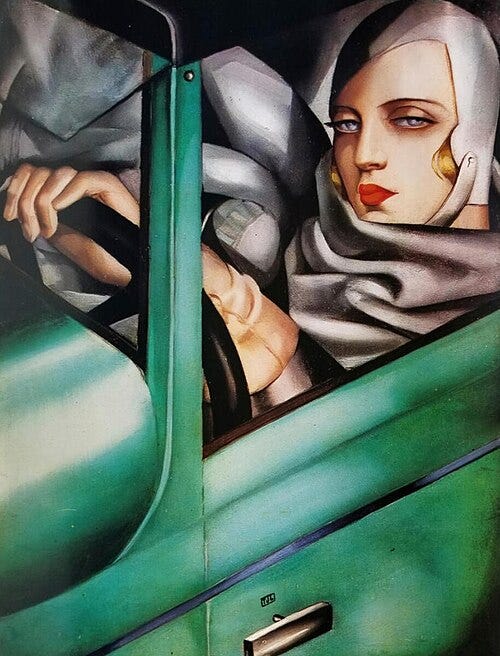Artwork of the Month: Tamara de Lempicka's "Self-Portrait (Tamara in a Green Bugatti)"

The iconic "Self-Portrait (Tamara in a Green Bugatti)" by Tamara de Lempicka, painted in 1929, reflects the artist's personal lifestyle and is a testament to the era's fascination with speed, technology, and women's independence.
Tamara de Lempicka was born into a wealthy and influential family in Warsaw, Poland, around 1898. Her early life was marked by luxury and travel, which later influenced her artistic style. Having survived the Russian Revolution, she settled in Paris, where she refined her creative abilities and became a famous portrait painter for the city's elite.
De Lempicka's art combines Art Deco aesthetics, stylized cubism, and, to some extent, Italian futurism. Her subjects, often depicted with smooth contours and geometric forms, radiate urban sophistication and independence. This unique style appealed to the tastes of the wealthy bourgeoisie of the time, making her a favourite of Parisian high society.
De Lempicka's work experienced a new wave of popularity in the 1970s when there was renewed interest in the Art Deco style. However, her legacy faced challenges competing with the works of her male contemporaries. In recent years, interest has risen again—descendants have successfully brought attention to the artist's work and the importance of her personality in history.
In 2023, Tamara de Lempicka's works reached an impressive hammer price of $17.1 million with an average price of $812,114.03 per lot. However, in 2024, sales decreased significantly: the total hammer price dropped to $1.6 million, and the average price fell to $115,275.14. This is not a trend – just a different supply and demand situation in different years.
The Artwork: "Self-Portrait (Tamara in a Green Bugatti)"
"Self-Portrait (Tamara in a Green Bugatti)" is one of de Lempicka's most famous works, revealing the modern woman of the interwar period. The painting depicts the artist herself at the wheel of an elegant green Bugatti, embodying the spirit of freedom. The facial features are painted monumentally and resemble ancient Greek sculptures, while the attire – with a small aviator's helmet and gloves – reflects the era's fascination with aviation and speed.
The use of bright, monochromatic elements and the stylized signature at the bottom of the painting reflect de Lempicka's innovative approach to colour and form. This work is not just a self-portrait but also a declaration of women's empowerment, as driving automobiles was a symbol of independence when women broke free from traditional roles.
Inspiration
De Lempicka's inspiration for this painting was multifaceted. A commission from "Die Dame," a German fashion magazine, aimed to commemorate women's emancipation, giving her an excellent opportunity to create a work that would embody the modern woman of the time. Her style and fascination with luxury and speed also influenced her choice to depict a Bugatti, although she owned a small yellow Renault.
A similar composition may have influenced the painting in André Kertész's 1927 photograph. Furthermore, the flowing scarf in the painting could be a reference to Isadora Duncan, a famous dancer who tragically died in a car accident involving her scarf.




